

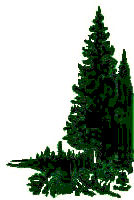
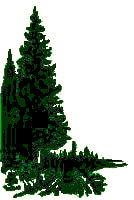
The business of commercial fishing goes back to the very early history of this area and has played an important role throughout the years. Just after the turn of the century, Mr. E.C. Brownfield made a trip from Prince Albert to Stoney Lake and began trading with the natives. He would bring in supplies and take out fur and fish. He soon realized the excellent possibilities of commercial fishing in the northern lakes. in 1909, Dave Overly came up from Indiana to go hunting in the Prince Albert country. While there, he met Mr. Brownfield and listened with keen interest as he told of the many lakes and of his feeling that commercial fishing would be a good investment. Mr. Overly decided to give it a try. However, he was not the only one who had a fish buying company in mind. Mr. Martin Olsen, a representative of Booth Fisheries of Winnipeg arrived in Big River ready to establish a business. A small company was formed and became known as the Ile-a-la-Crosse Fish Company. Later this was shortened to the I.C. Fish Company. A warehouse was built at Big River and a fish warehouse and fur farm established at Ile-a-la-Crosse. The company flourished for a short while but wasn't too successful and soon ceased to operate. Mr. Olsen continued in the fish business on his own for many years after this. Mr. Overly returned to Indiana where he succeeded in persuading his nephew, George Rizer, to join him in another fishing venture. In 1911, after purchasing some nets in Chicago, they journeyed north and set up their first fish camp at Dog Lake (Smoothstone). Once again the business proved unsuccessful and again they returned to the States. However, in 1913, they decided to see some fish dealers in Chicago and inquire if they would be interested in fish from Northern Saskatchewan. Mr. Rizer talked to the Sales Manager of Booth Fisheries who simply told him to let him know if they caught anything and then he would send shipping instructions. 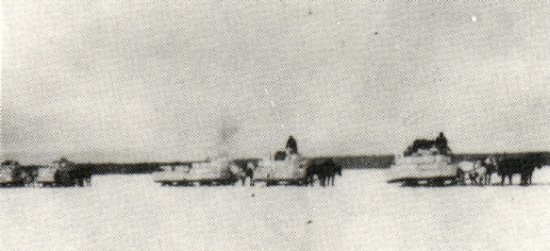
Hauling fish with horses.
In due time, the two men would be back in Big River to try their luck again. This time they went to Dore Lake where they set their nets and found they were filled with fish the first time they raised them. The fishing was so good they didn't have time to set all their nets. Mr. Rizer walked back to Big River to get some freighters to take in fish boxes and to haul the fish out to the railway. He hired Alex Delaronde, who got eight teams of freighters and they went after the fish. THey no sooner arrived back in Big River than word came from Mr. Overly to send the teams right back as he had plenty more fish for another load. Mr. Rizer stayed in town to load the fish on the train and ship it to Chicago. He wondered what he would do if Booth's inspector rejected the shipment. He need not have worried, for word came back they would take all the fish they could supply. That winter they shipped three carloads of fish and this was the beginning of Big River Consolidated Fisheries. An office building and warehouse were constructed down by the lake near the railway tracks in the south west end of town. The fisheries continued until 1933, when the price of fish dropped so low that they weren't worth the cost of freight and boxes. When prices recovered somewhat the Rizer family started a new fish company, The Big River Fisheries Limited. This business operated until 1945 when the name and the business were sold to Waite Fisheries Limited. 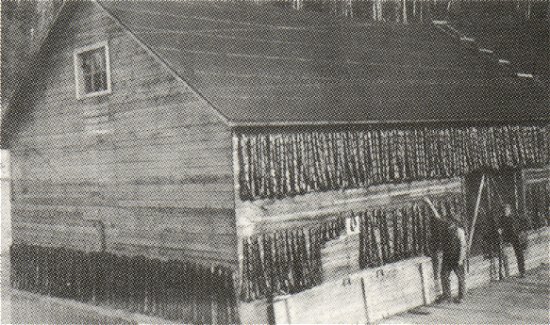
Big River Consolidated Fisheries.
Other fish buyers at that time were: Olafson's Fish Company, Skivek's, Verner Johnson, Brownfield's, O.P.Godin, Martin Olsen, and Nels Edson. During the years when employment was hard to find, men often resorted to fishing to try to make a little money. Most buyers would 'stake' a fisherman for the winter, providing him with the necessary clothing, food and equipment. Generally the fishermen would be away on the lakes from late November to early February. They would live in either a large fish camp operated by a buyer, or set up a small camp of their own. To do this it was necessary to haul a caboose in along with the supplies or to arrange to have the use of a trapper's shack during his stay on the lake. 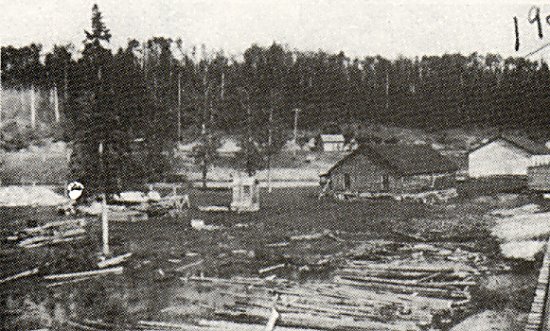
Big River Fisheries Limited.
The gear consisted of a small pony and sleigh, hay for the pony, nets and floats, packed in boxes ready to use, ice chisel, needle bar, axes and shovels. Personal equipment included warm clothing, lots of fishermen mitts and socks as well as moccasins, along with camp utensils and the food supply. Everyone recalls that a lot of beans and fish were on the menu. In some cases, those planning to fish would build a scow during the summer and take their supplies in by water route. Once at their destination, the scow would be taken apart and the lumber used to construct a shelter for the winter camp. Fishermen usually worked in pairs. Those running their own outfits would locate their caboose in a likely spot and bank it with snow at the first opportunity. This provided insulation against the wind and cold. A supply of firewood had to be seen to and a shelter provided for the pony that would be used to work on the ice once fishing commenced. Hay was stacked by the pony's shelter. Once the camp was made ready, fishing began as soon as the season was open, usually the first of December. Should fishing prove to be poor in the area chosen, the first freighter through would be asked to move the caboose and a similar camp would be established on another part of the lake. 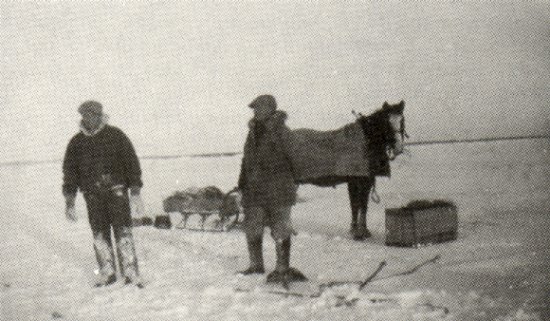
Ted Figeland and partner.
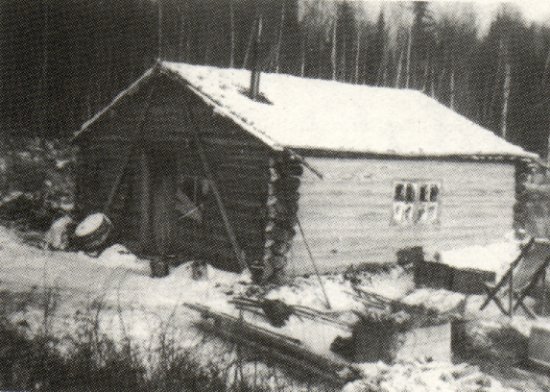
Nels Edson's fish camp - 1937.
The routine of a fisherman's day was to be up before daylight, feed the pony and get his own breakfast, then away to the fishing area at dawn, leaving themselves some daylight as it was very easy to get lost on the frozen lakes. Arriving at the fishing spot they dug a hole about two feet square through the ice. With the help of a 'jigger', a one hundred yard line was run under the ice and another hole was cut directly behind the jigger. The line was then pulled through by means of a wooden hook. The net was tied to the first net and was again pulled into place under the ice. A post was frozen into each hole and weighted down. Any number of nets can be set in a string but usually no more than twenty. Often test nets are set to find where the fishing is good. Nets are lifted at the basin hole, which is every second hole. Two nets are lifted onto the ice, first one and then the other. A line is always tied to the end of the net so if the catch is good it can be reset in the same place. As the net is lifted out of the water, the fishermen take the fish out and throw them in a pile on the lake. Care is taken to undo all tangles and knots in the net as well. The fish are then dressed and arranged so that they will freeze flat. If it is very cold they freeze quickly and must be packed while still limber enough to handle. Fish are packed in four layers in boxes holding about one hundred and fifty pounds each. Expert handling and packing ensures better quality and good appearance. All dead fish, suckers and ling (cod) are thrown in a scrap pile which grows larger as the winter catch increases. These scrap piles had to be cleared off the ice before the spring thaw. A clean-up day was arranged and the scrap heap hauled to shore. In later years, mink ranchers made use of this waste and bought it from fishermen on the ice. 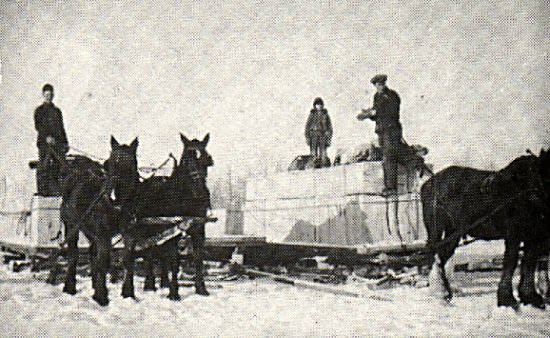
Martins hauling fish.
After all the nets were lifted and the catch attended to, the boxes were loaded on the sleigh and taken back to camp where they were stacked waiting for the next freighter to come and pick them up. Some of the larger fish camps in later years employed their own cook. The men were often transported out to the lakes by Model A trucks or Bombardiers. Three or four fishermen would drop off to attend to the day's catch. They would be picked up at the end of the day and brought back to camp. The noon meal was hauled out by pony and a stoneboat from the camp kitchen. Potatoes and beans seemed to be the main portion of the menu. The pay in the larger camps was often twenty dollars a month with board. Keeping mitts and socks in good condition was absolutely necessary. Mending was attended to as well as the chore of washing the mitts each night and hanging them over the wood heater to dry. Some of the fishermen recall having to battle with lice and a general bath day was often in order for the comfort of all. 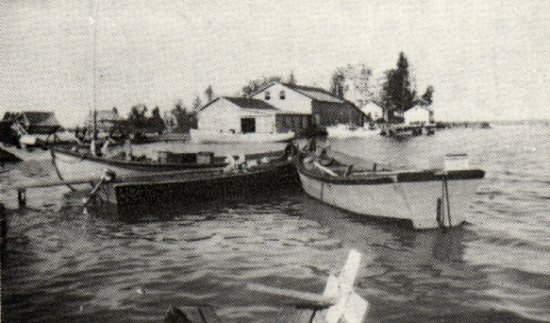
Waites Filleting Plant - Dore Lake.
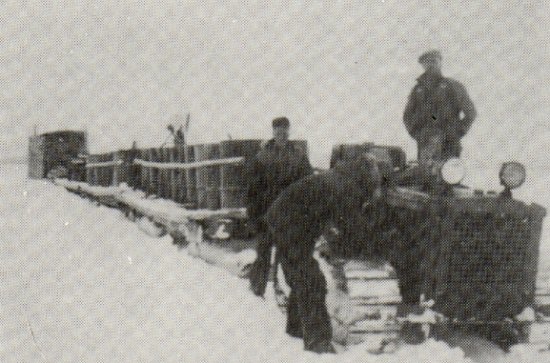
Verle McIntosh taking fuel to Cree Lake.
Waite Fisheries Ltd. built a filleting plant on Dore in 1945 and commercial fresh fishing began. Gear Thordan, Tom Scrimshaw and Raymond Servatius were the first to put their nets down. Kurt Bengston, Horace Chenard and Tom Scrimshaw built boats in Waite's basement in town and then the boats were hauled to Dore. Ice had to be put up at Dore and Cree Lakes for use in the fresh fishing business. Fuel for summer was hauled in during the winter months so that the frozen lakes could be used for roads. Verle McIntosh had an outfit employed in this work. In order to keep the fish from freezing during winter, fresh fishing cabooses were equipped with wood stoves which had to be kept going during the haul south. The men cut firewood along the trail. Alonzo Gallant spent many years fishing and recalls fish camps at Gallant's Point, Dog Lake, Stoney, Burnt Lake, Elaine Lake, Fish Point, Ladder Lake and Dore to name a few. Gaudoise Tremblay, who fished and freighted for many years in the north talked of some of his experiences in the early days. Perhaps the most memorable was the time he and Mr. Gallant Sr. went fishing at Keeley Lake. They had eight to ten nets between them. One cold night, Mr. Gallant was washing up the mitts in the far end of the shack and Gaudoise built up a good fire in the heater. Somehow the fuel can exploded and the whole shack was on fire in seconds. Both men were badly burned. After much pain and hardship, they managed to get to the hospital in Ile-a-la-Crosse. Unfortunately, Mr. Gallant died a few days later from the burns. Gaudoise was in hospital a long time but a few years later, he was back on the ice and fishing once more. Most fishermen agree it was a hard, cold job with very small pay, but somehow it had its rewards for they seem to remember those days with a certain pleasure. 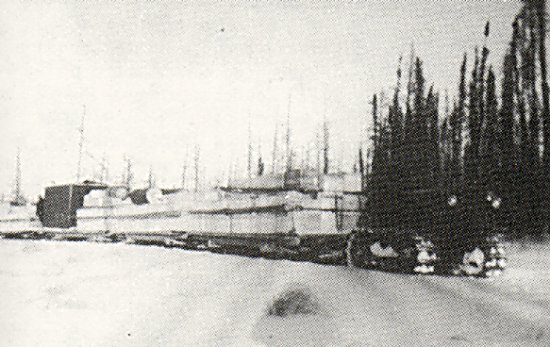
Fish swing with tractor.
|
| Deep River Fur Farm |
| Deep River Trapping Page |
| Deep River Fishing Page |
| My Norwegian Roots |
| Early Mink People Canada - Bowness |
| The Manager's Tale - Hugh Ross |
| Sakitawak Bi-Centennial - 200 Yrs. |
| Lost Land of the Caribou - Ed Theriau |
| The History of Buffalo Narrows |
| Hugh (Lefty) McLeod, Bush Pilot |
| George Greening, Bush Pilot |
| Timber Trails - History of Big River |
| Joe Anstett, Trapper |
| Bill Windrum, Bush Pilot |
| Face the North Wind - Art Karas |
| North to Cree Lake - Art Karas |
| Look at the Past - History Dore Lake |
| George Abbott Family History |
| These Are The Prairies |
| William A. A. Jay, Trapper |
| John Hedlund, Trapper |
| Deep River Photo Gallery |
| Cyril Mahoney, Trapper |
| Saskatchewan Pictorial History |
| Who's Who in furs - 1956 |
| Century in the Making - Big River |
| Wings Beyond Road's End |
| The Northern Trapper, 1923 |
| My Various Links Page |
| Ron Clancy, Author |
| Roman Catholic Church - 1849 |
| Frontier Characters - Ron Clancy |
| Northern Trader - Ron Clancy |
| Various Deep River Videos |
| How the Indians Used the Birch |
| Mink and Fish - Buffalo Narrows |
| Gold and Other Stories - Richards |
